MA601: Report Analyzing Theory and Current Issues in Accounting
VerifiedAdded on 2023/06/04
|13
|3479
|258
Report
AI Summary
This report offers a comprehensive analysis of accounting theory and current issues, focusing on the Australian Accounting Conceptual Framework. It dissects the five key elements of financial statements: assets, liabilities, equity, revenue, and expenses, detailing their definitions and recognition criteria. The report evaluates the characteristics and measurement of assets, including the application of fair value and amortized cost under AASB 139. It critically assesses the historical cost method, exploring its advantages and limitations. Furthermore, the report examines the absence of references to disclosure practices in the 2014 framework and analyzes asset measurement and reporting procedures for ASX-listed companies. The analysis draws on the steward theory to evaluate the role of accountants and financial reporting in decision-making. The report concludes with recommendations for entities using the conceptual framework in financial statement preparation.
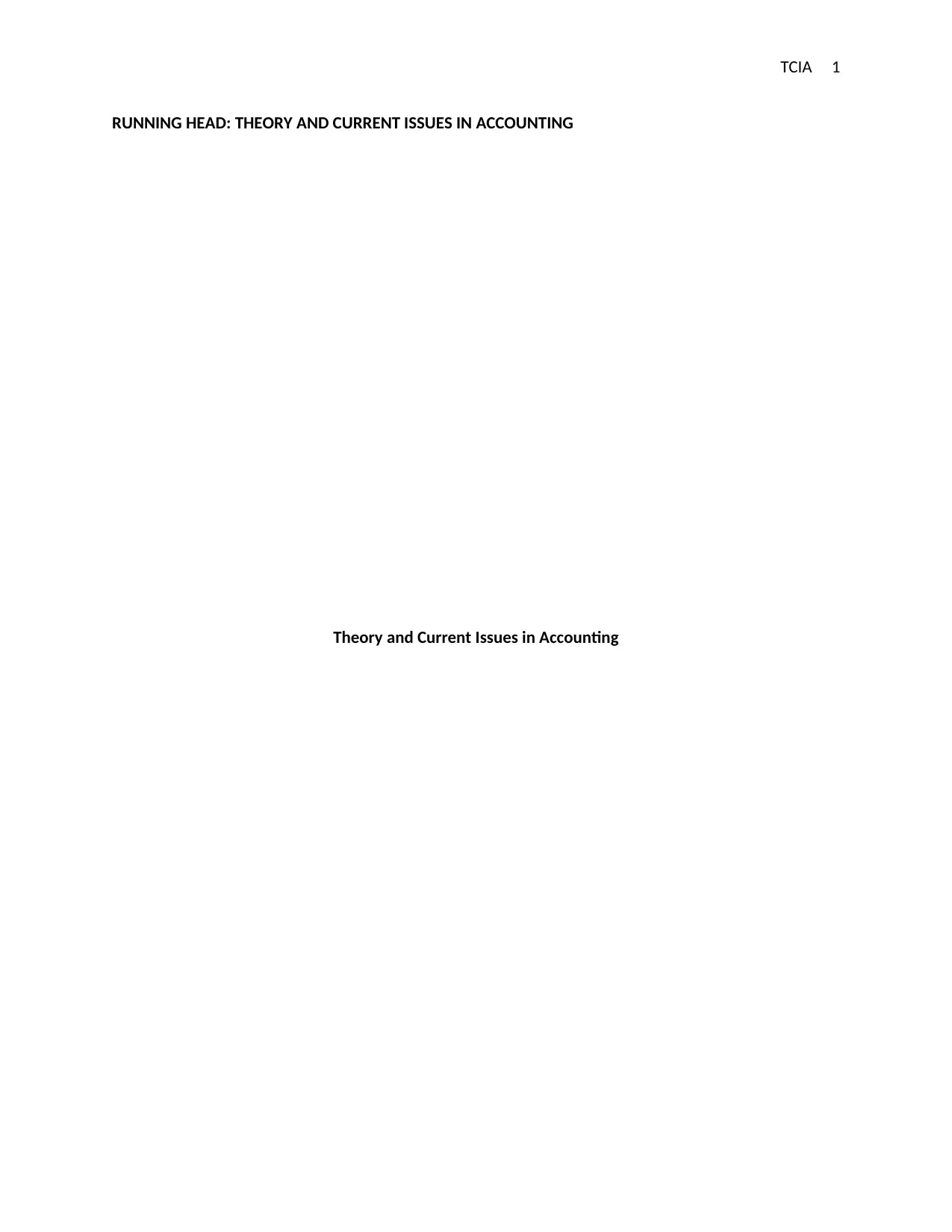
TCIA 1
RUNNING HEAD: THEORY AND CURRENT ISSUES IN ACCOUNTING
Theory and Current Issues in Accounting
RUNNING HEAD: THEORY AND CURRENT ISSUES IN ACCOUNTING
Theory and Current Issues in Accounting
Paraphrase This Document
Need a fresh take? Get an instant paraphrase of this document with our AI Paraphraser
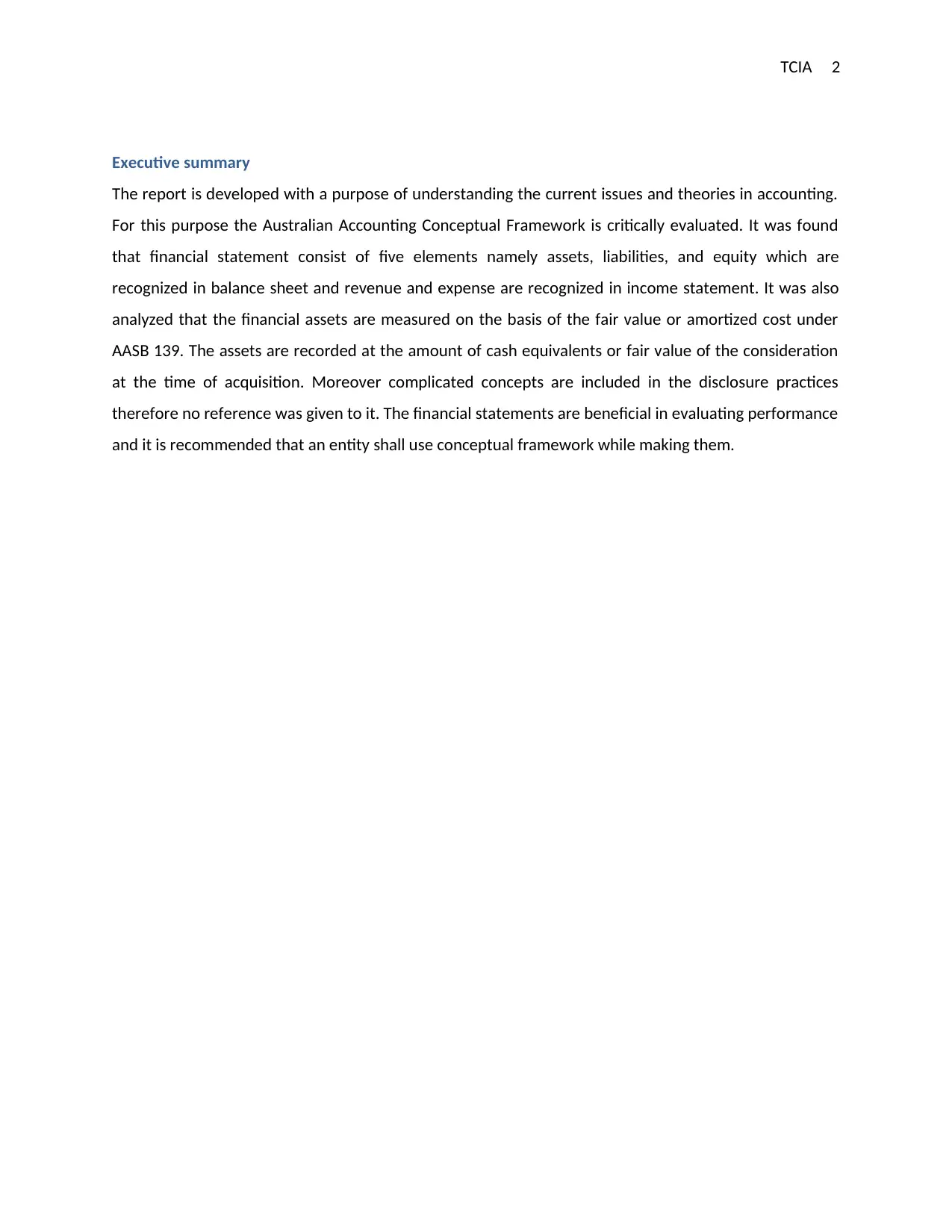
TCIA 2
Executive summary
The report is developed with a purpose of understanding the current issues and theories in accounting.
For this purpose the Australian Accounting Conceptual Framework is critically evaluated. It was found
that financial statement consist of five elements namely assets, liabilities, and equity which are
recognized in balance sheet and revenue and expense are recognized in income statement. It was also
analyzed that the financial assets are measured on the basis of the fair value or amortized cost under
AASB 139. The assets are recorded at the amount of cash equivalents or fair value of the consideration
at the time of acquisition. Moreover complicated concepts are included in the disclosure practices
therefore no reference was given to it. The financial statements are beneficial in evaluating performance
and it is recommended that an entity shall use conceptual framework while making them.
Executive summary
The report is developed with a purpose of understanding the current issues and theories in accounting.
For this purpose the Australian Accounting Conceptual Framework is critically evaluated. It was found
that financial statement consist of five elements namely assets, liabilities, and equity which are
recognized in balance sheet and revenue and expense are recognized in income statement. It was also
analyzed that the financial assets are measured on the basis of the fair value or amortized cost under
AASB 139. The assets are recorded at the amount of cash equivalents or fair value of the consideration
at the time of acquisition. Moreover complicated concepts are included in the disclosure practices
therefore no reference was given to it. The financial statements are beneficial in evaluating performance
and it is recommended that an entity shall use conceptual framework while making them.
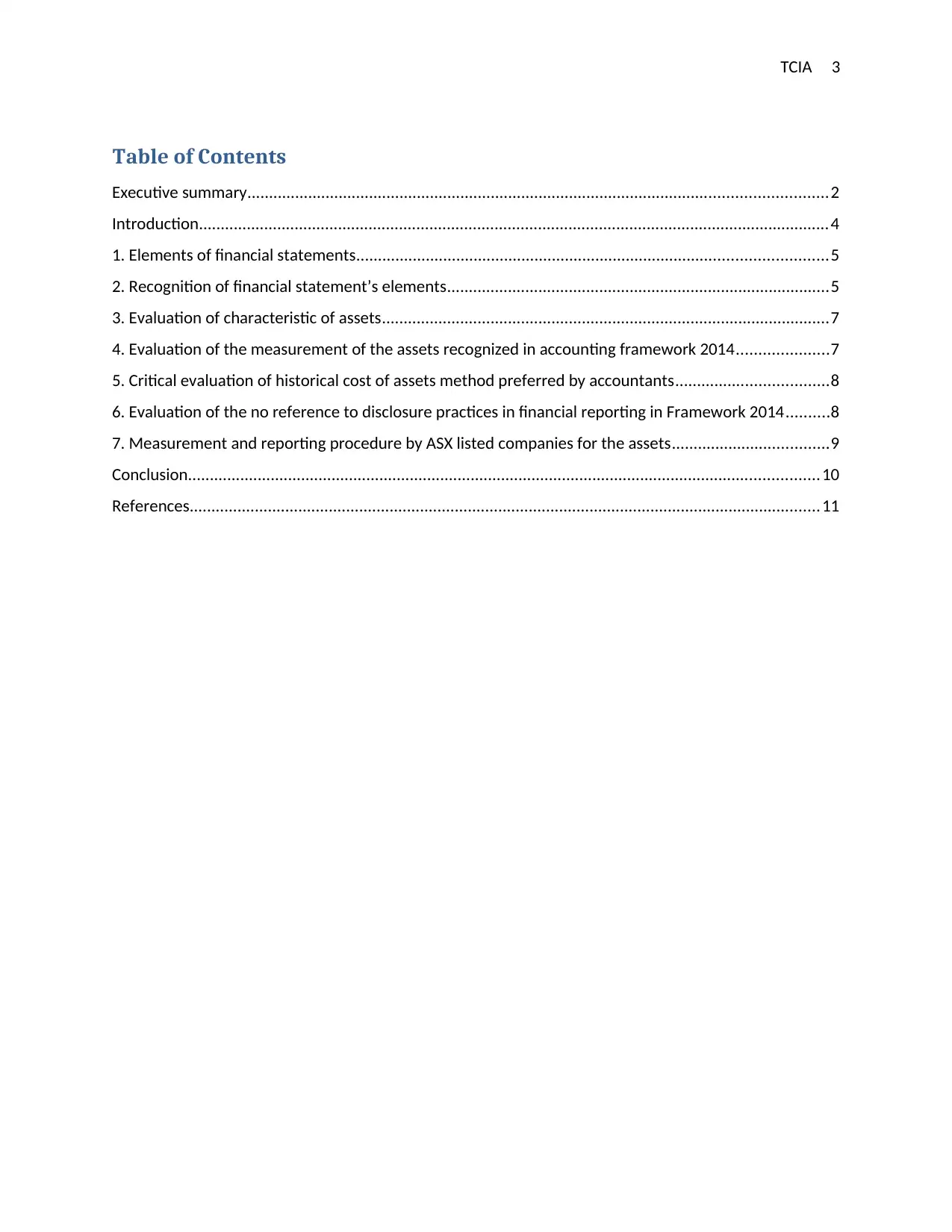
TCIA 3
Table of Contents
Executive summary.....................................................................................................................................2
Introduction.................................................................................................................................................4
1. Elements of financial statements............................................................................................................5
2. Recognition of financial statement’s elements........................................................................................5
3. Evaluation of characteristic of assets.......................................................................................................7
4. Evaluation of the measurement of the assets recognized in accounting framework 2014.....................7
5. Critical evaluation of historical cost of assets method preferred by accountants...................................8
6. Evaluation of the no reference to disclosure practices in financial reporting in Framework 2014..........8
7. Measurement and reporting procedure by ASX listed companies for the assets....................................9
Conclusion.................................................................................................................................................10
References.................................................................................................................................................11
Table of Contents
Executive summary.....................................................................................................................................2
Introduction.................................................................................................................................................4
1. Elements of financial statements............................................................................................................5
2. Recognition of financial statement’s elements........................................................................................5
3. Evaluation of characteristic of assets.......................................................................................................7
4. Evaluation of the measurement of the assets recognized in accounting framework 2014.....................7
5. Critical evaluation of historical cost of assets method preferred by accountants...................................8
6. Evaluation of the no reference to disclosure practices in financial reporting in Framework 2014..........8
7. Measurement and reporting procedure by ASX listed companies for the assets....................................9
Conclusion.................................................................................................................................................10
References.................................................................................................................................................11
⊘ This is a preview!⊘
Do you want full access?
Subscribe today to unlock all pages.

Trusted by 1+ million students worldwide
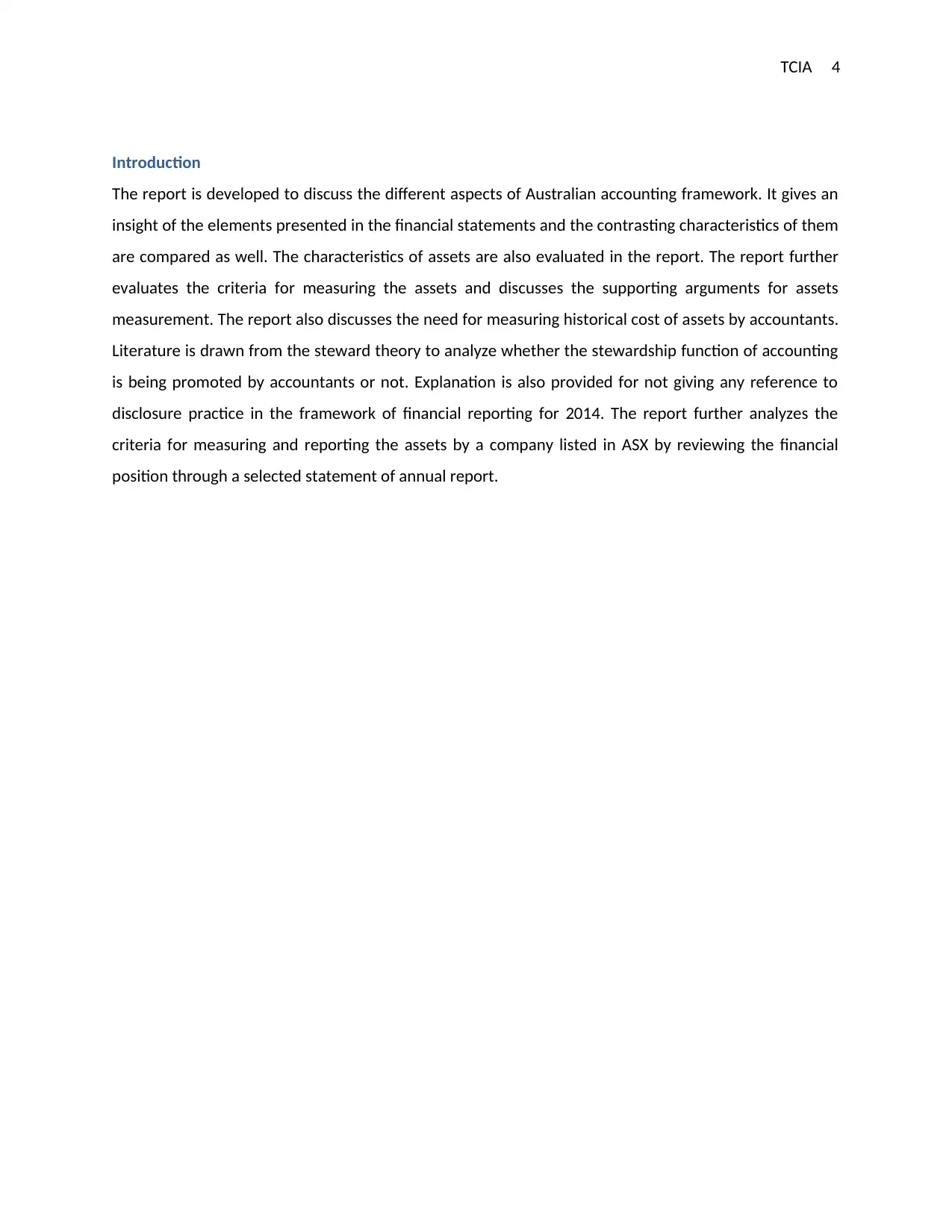
TCIA 4
Introduction
The report is developed to discuss the different aspects of Australian accounting framework. It gives an
insight of the elements presented in the financial statements and the contrasting characteristics of them
are compared as well. The characteristics of assets are also evaluated in the report. The report further
evaluates the criteria for measuring the assets and discusses the supporting arguments for assets
measurement. The report also discusses the need for measuring historical cost of assets by accountants.
Literature is drawn from the steward theory to analyze whether the stewardship function of accounting
is being promoted by accountants or not. Explanation is also provided for not giving any reference to
disclosure practice in the framework of financial reporting for 2014. The report further analyzes the
criteria for measuring and reporting the assets by a company listed in ASX by reviewing the financial
position through a selected statement of annual report.
Introduction
The report is developed to discuss the different aspects of Australian accounting framework. It gives an
insight of the elements presented in the financial statements and the contrasting characteristics of them
are compared as well. The characteristics of assets are also evaluated in the report. The report further
evaluates the criteria for measuring the assets and discusses the supporting arguments for assets
measurement. The report also discusses the need for measuring historical cost of assets by accountants.
Literature is drawn from the steward theory to analyze whether the stewardship function of accounting
is being promoted by accountants or not. Explanation is also provided for not giving any reference to
disclosure practice in the framework of financial reporting for 2014. The report further analyzes the
criteria for measuring and reporting the assets by a company listed in ASX by reviewing the financial
position through a selected statement of annual report.
Paraphrase This Document
Need a fresh take? Get an instant paraphrase of this document with our AI Paraphraser
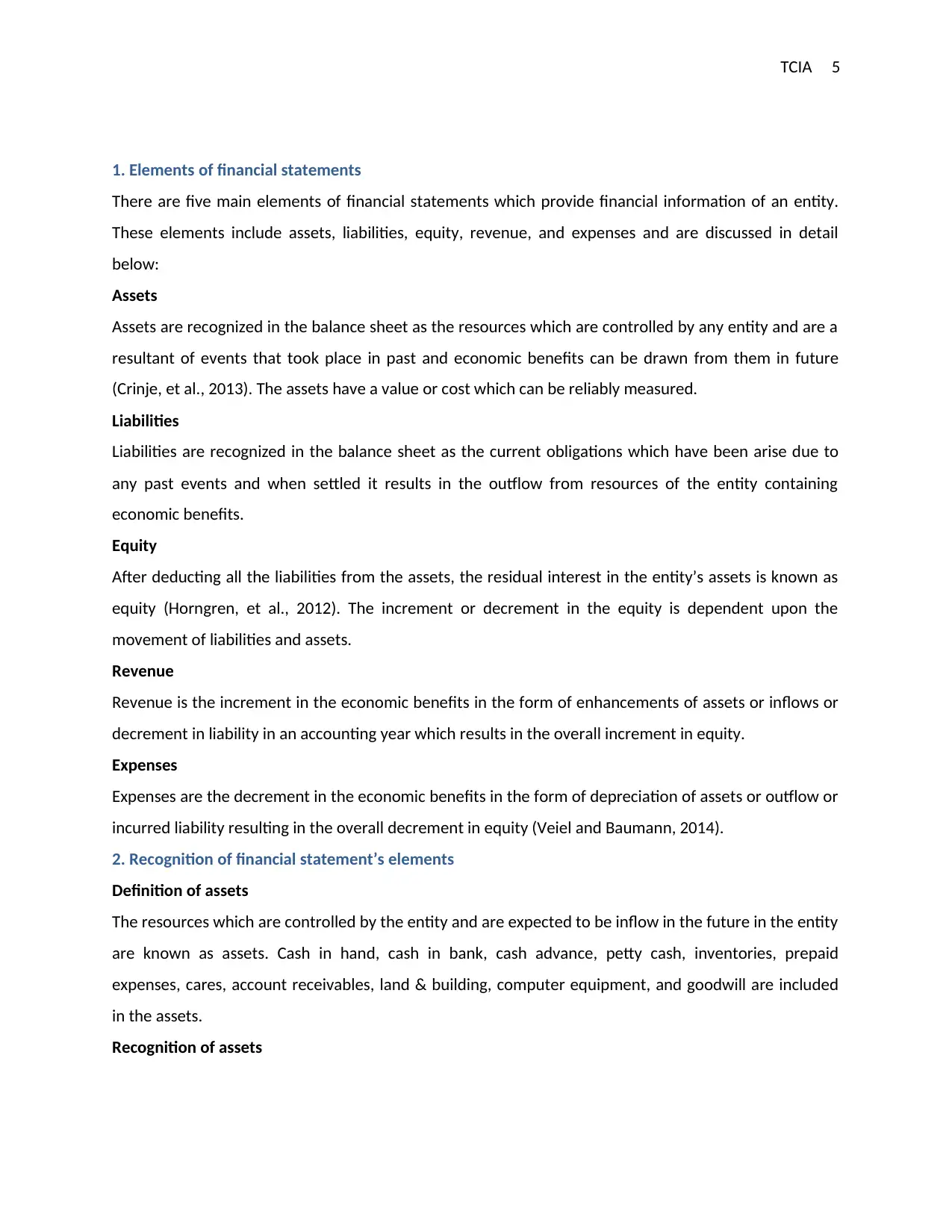
TCIA 5
1. Elements of financial statements
There are five main elements of financial statements which provide financial information of an entity.
These elements include assets, liabilities, equity, revenue, and expenses and are discussed in detail
below:
Assets
Assets are recognized in the balance sheet as the resources which are controlled by any entity and are a
resultant of events that took place in past and economic benefits can be drawn from them in future
(Crinje, et al., 2013). The assets have a value or cost which can be reliably measured.
Liabilities
Liabilities are recognized in the balance sheet as the current obligations which have been arise due to
any past events and when settled it results in the outflow from resources of the entity containing
economic benefits.
Equity
After deducting all the liabilities from the assets, the residual interest in the entity’s assets is known as
equity (Horngren, et al., 2012). The increment or decrement in the equity is dependent upon the
movement of liabilities and assets.
Revenue
Revenue is the increment in the economic benefits in the form of enhancements of assets or inflows or
decrement in liability in an accounting year which results in the overall increment in equity.
Expenses
Expenses are the decrement in the economic benefits in the form of depreciation of assets or outflow or
incurred liability resulting in the overall decrement in equity (Veiel and Baumann, 2014).
2. Recognition of financial statement’s elements
Definition of assets
The resources which are controlled by the entity and are expected to be inflow in the future in the entity
are known as assets. Cash in hand, cash in bank, cash advance, petty cash, inventories, prepaid
expenses, cares, account receivables, land & building, computer equipment, and goodwill are included
in the assets.
Recognition of assets
1. Elements of financial statements
There are five main elements of financial statements which provide financial information of an entity.
These elements include assets, liabilities, equity, revenue, and expenses and are discussed in detail
below:
Assets
Assets are recognized in the balance sheet as the resources which are controlled by any entity and are a
resultant of events that took place in past and economic benefits can be drawn from them in future
(Crinje, et al., 2013). The assets have a value or cost which can be reliably measured.
Liabilities
Liabilities are recognized in the balance sheet as the current obligations which have been arise due to
any past events and when settled it results in the outflow from resources of the entity containing
economic benefits.
Equity
After deducting all the liabilities from the assets, the residual interest in the entity’s assets is known as
equity (Horngren, et al., 2012). The increment or decrement in the equity is dependent upon the
movement of liabilities and assets.
Revenue
Revenue is the increment in the economic benefits in the form of enhancements of assets or inflows or
decrement in liability in an accounting year which results in the overall increment in equity.
Expenses
Expenses are the decrement in the economic benefits in the form of depreciation of assets or outflow or
incurred liability resulting in the overall decrement in equity (Veiel and Baumann, 2014).
2. Recognition of financial statement’s elements
Definition of assets
The resources which are controlled by the entity and are expected to be inflow in the future in the entity
are known as assets. Cash in hand, cash in bank, cash advance, petty cash, inventories, prepaid
expenses, cares, account receivables, land & building, computer equipment, and goodwill are included
in the assets.
Recognition of assets
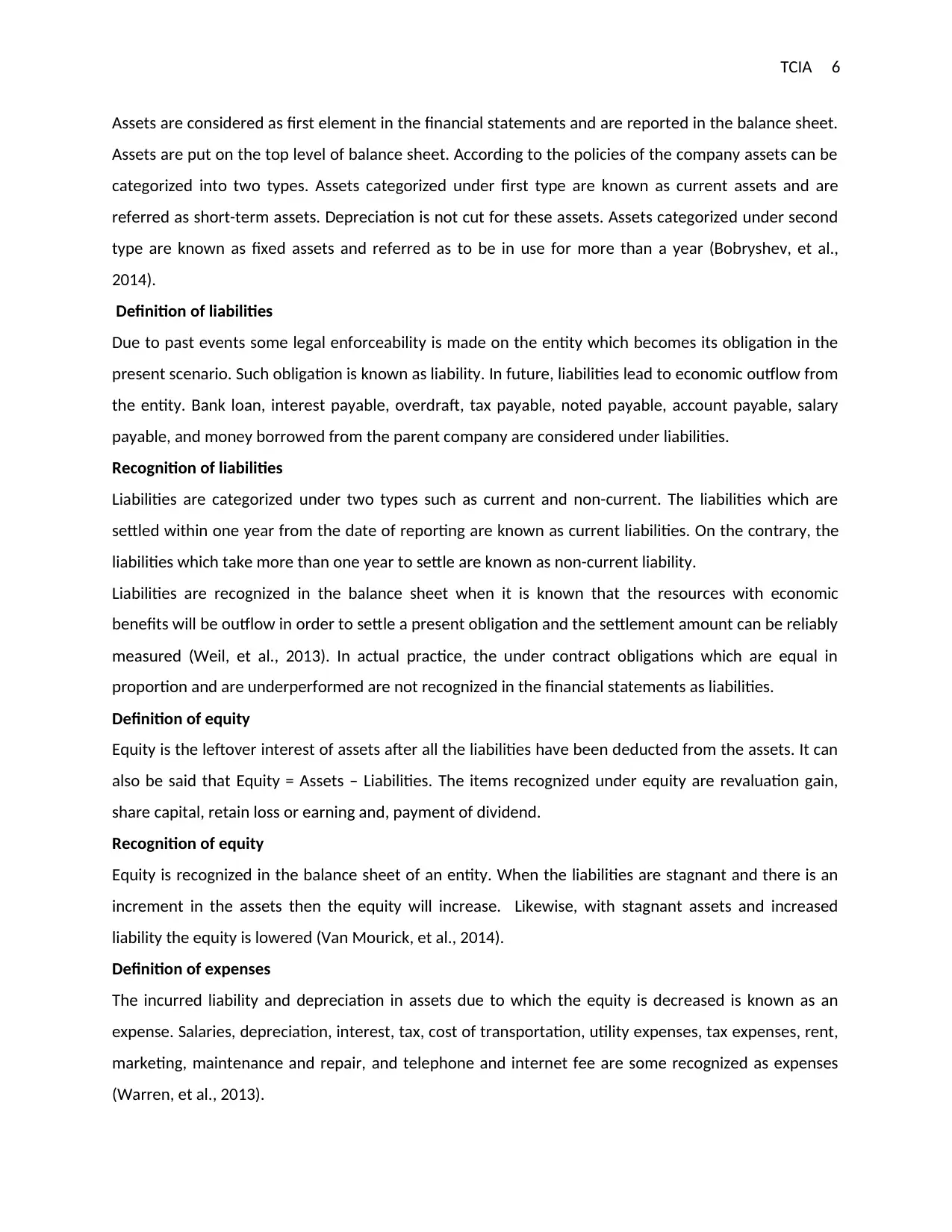
TCIA 6
Assets are considered as first element in the financial statements and are reported in the balance sheet.
Assets are put on the top level of balance sheet. According to the policies of the company assets can be
categorized into two types. Assets categorized under first type are known as current assets and are
referred as short-term assets. Depreciation is not cut for these assets. Assets categorized under second
type are known as fixed assets and referred as to be in use for more than a year (Bobryshev, et al.,
2014).
Definition of liabilities
Due to past events some legal enforceability is made on the entity which becomes its obligation in the
present scenario. Such obligation is known as liability. In future, liabilities lead to economic outflow from
the entity. Bank loan, interest payable, overdraft, tax payable, noted payable, account payable, salary
payable, and money borrowed from the parent company are considered under liabilities.
Recognition of liabilities
Liabilities are categorized under two types such as current and non-current. The liabilities which are
settled within one year from the date of reporting are known as current liabilities. On the contrary, the
liabilities which take more than one year to settle are known as non-current liability.
Liabilities are recognized in the balance sheet when it is known that the resources with economic
benefits will be outflow in order to settle a present obligation and the settlement amount can be reliably
measured (Weil, et al., 2013). In actual practice, the under contract obligations which are equal in
proportion and are underperformed are not recognized in the financial statements as liabilities.
Definition of equity
Equity is the leftover interest of assets after all the liabilities have been deducted from the assets. It can
also be said that Equity = Assets – Liabilities. The items recognized under equity are revaluation gain,
share capital, retain loss or earning and, payment of dividend.
Recognition of equity
Equity is recognized in the balance sheet of an entity. When the liabilities are stagnant and there is an
increment in the assets then the equity will increase. Likewise, with stagnant assets and increased
liability the equity is lowered (Van Mourick, et al., 2014).
Definition of expenses
The incurred liability and depreciation in assets due to which the equity is decreased is known as an
expense. Salaries, depreciation, interest, tax, cost of transportation, utility expenses, tax expenses, rent,
marketing, maintenance and repair, and telephone and internet fee are some recognized as expenses
(Warren, et al., 2013).
Assets are considered as first element in the financial statements and are reported in the balance sheet.
Assets are put on the top level of balance sheet. According to the policies of the company assets can be
categorized into two types. Assets categorized under first type are known as current assets and are
referred as short-term assets. Depreciation is not cut for these assets. Assets categorized under second
type are known as fixed assets and referred as to be in use for more than a year (Bobryshev, et al.,
2014).
Definition of liabilities
Due to past events some legal enforceability is made on the entity which becomes its obligation in the
present scenario. Such obligation is known as liability. In future, liabilities lead to economic outflow from
the entity. Bank loan, interest payable, overdraft, tax payable, noted payable, account payable, salary
payable, and money borrowed from the parent company are considered under liabilities.
Recognition of liabilities
Liabilities are categorized under two types such as current and non-current. The liabilities which are
settled within one year from the date of reporting are known as current liabilities. On the contrary, the
liabilities which take more than one year to settle are known as non-current liability.
Liabilities are recognized in the balance sheet when it is known that the resources with economic
benefits will be outflow in order to settle a present obligation and the settlement amount can be reliably
measured (Weil, et al., 2013). In actual practice, the under contract obligations which are equal in
proportion and are underperformed are not recognized in the financial statements as liabilities.
Definition of equity
Equity is the leftover interest of assets after all the liabilities have been deducted from the assets. It can
also be said that Equity = Assets – Liabilities. The items recognized under equity are revaluation gain,
share capital, retain loss or earning and, payment of dividend.
Recognition of equity
Equity is recognized in the balance sheet of an entity. When the liabilities are stagnant and there is an
increment in the assets then the equity will increase. Likewise, with stagnant assets and increased
liability the equity is lowered (Van Mourick, et al., 2014).
Definition of expenses
The incurred liability and depreciation in assets due to which the equity is decreased is known as an
expense. Salaries, depreciation, interest, tax, cost of transportation, utility expenses, tax expenses, rent,
marketing, maintenance and repair, and telephone and internet fee are some recognized as expenses
(Warren, et al., 2013).
⊘ This is a preview!⊘
Do you want full access?
Subscribe today to unlock all pages.

Trusted by 1+ million students worldwide
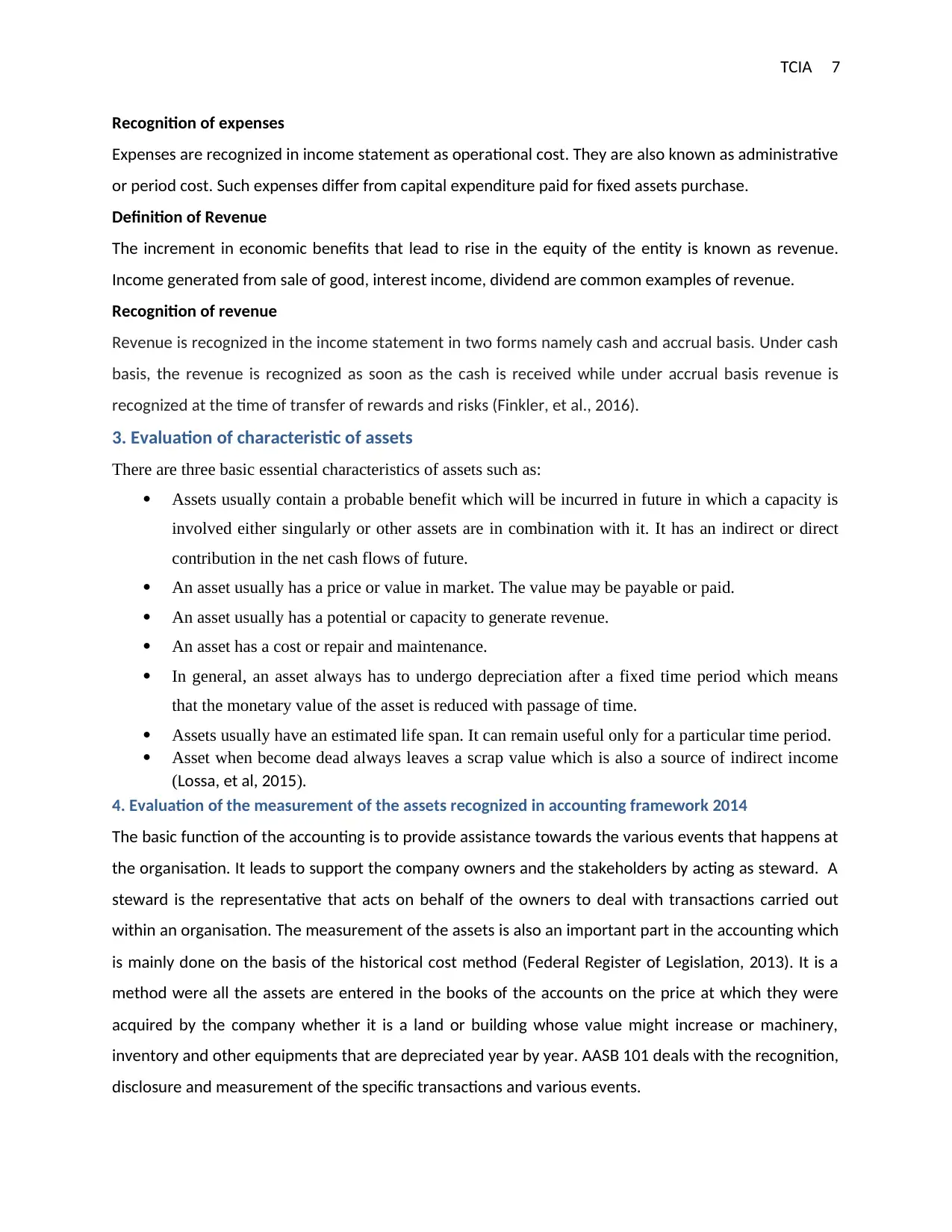
TCIA 7
Recognition of expenses
Expenses are recognized in income statement as operational cost. They are also known as administrative
or period cost. Such expenses differ from capital expenditure paid for fixed assets purchase.
Definition of Revenue
The increment in economic benefits that lead to rise in the equity of the entity is known as revenue.
Income generated from sale of good, interest income, dividend are common examples of revenue.
Recognition of revenue
Revenue is recognized in the income statement in two forms namely cash and accrual basis. Under cash
basis, the revenue is recognized as soon as the cash is received while under accrual basis revenue is
recognized at the time of transfer of rewards and risks (Finkler, et al., 2016).
3. Evaluation of characteristic of assets
There are three basic essential characteristics of assets such as:
Assets usually contain a probable benefit which will be incurred in future in which a capacity is
involved either singularly or other assets are in combination with it. It has an indirect or direct
contribution in the net cash flows of future.
An asset usually has a price or value in market. The value may be payable or paid.
An asset usually has a potential or capacity to generate revenue.
An asset has a cost or repair and maintenance.
In general, an asset always has to undergo depreciation after a fixed time period which means
that the monetary value of the asset is reduced with passage of time.
Assets usually have an estimated life span. It can remain useful only for a particular time period.
Asset when become dead always leaves a scrap value which is also a source of indirect income
(Lossa, et al, 2015).
4. Evaluation of the measurement of the assets recognized in accounting framework 2014
The basic function of the accounting is to provide assistance towards the various events that happens at
the organisation. It leads to support the company owners and the stakeholders by acting as steward. A
steward is the representative that acts on behalf of the owners to deal with transactions carried out
within an organisation. The measurement of the assets is also an important part in the accounting which
is mainly done on the basis of the historical cost method (Federal Register of Legislation, 2013). It is a
method were all the assets are entered in the books of the accounts on the price at which they were
acquired by the company whether it is a land or building whose value might increase or machinery,
inventory and other equipments that are depreciated year by year. AASB 101 deals with the recognition,
disclosure and measurement of the specific transactions and various events.
Recognition of expenses
Expenses are recognized in income statement as operational cost. They are also known as administrative
or period cost. Such expenses differ from capital expenditure paid for fixed assets purchase.
Definition of Revenue
The increment in economic benefits that lead to rise in the equity of the entity is known as revenue.
Income generated from sale of good, interest income, dividend are common examples of revenue.
Recognition of revenue
Revenue is recognized in the income statement in two forms namely cash and accrual basis. Under cash
basis, the revenue is recognized as soon as the cash is received while under accrual basis revenue is
recognized at the time of transfer of rewards and risks (Finkler, et al., 2016).
3. Evaluation of characteristic of assets
There are three basic essential characteristics of assets such as:
Assets usually contain a probable benefit which will be incurred in future in which a capacity is
involved either singularly or other assets are in combination with it. It has an indirect or direct
contribution in the net cash flows of future.
An asset usually has a price or value in market. The value may be payable or paid.
An asset usually has a potential or capacity to generate revenue.
An asset has a cost or repair and maintenance.
In general, an asset always has to undergo depreciation after a fixed time period which means
that the monetary value of the asset is reduced with passage of time.
Assets usually have an estimated life span. It can remain useful only for a particular time period.
Asset when become dead always leaves a scrap value which is also a source of indirect income
(Lossa, et al, 2015).
4. Evaluation of the measurement of the assets recognized in accounting framework 2014
The basic function of the accounting is to provide assistance towards the various events that happens at
the organisation. It leads to support the company owners and the stakeholders by acting as steward. A
steward is the representative that acts on behalf of the owners to deal with transactions carried out
within an organisation. The measurement of the assets is also an important part in the accounting which
is mainly done on the basis of the historical cost method (Federal Register of Legislation, 2013). It is a
method were all the assets are entered in the books of the accounts on the price at which they were
acquired by the company whether it is a land or building whose value might increase or machinery,
inventory and other equipments that are depreciated year by year. AASB 101 deals with the recognition,
disclosure and measurement of the specific transactions and various events.
Paraphrase This Document
Need a fresh take? Get an instant paraphrase of this document with our AI Paraphraser
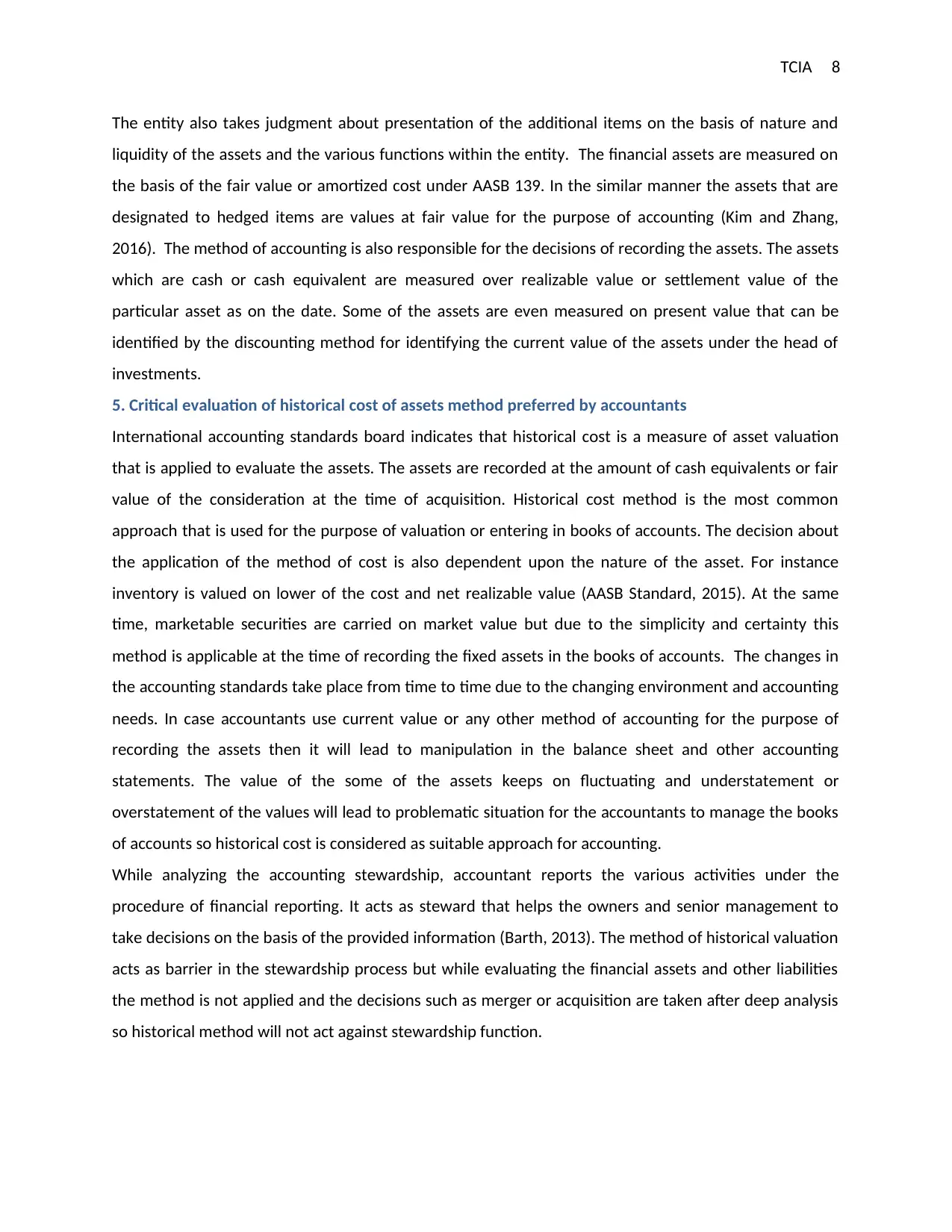
TCIA 8
The entity also takes judgment about presentation of the additional items on the basis of nature and
liquidity of the assets and the various functions within the entity. The financial assets are measured on
the basis of the fair value or amortized cost under AASB 139. In the similar manner the assets that are
designated to hedged items are values at fair value for the purpose of accounting (Kim and Zhang,
2016). The method of accounting is also responsible for the decisions of recording the assets. The assets
which are cash or cash equivalent are measured over realizable value or settlement value of the
particular asset as on the date. Some of the assets are even measured on present value that can be
identified by the discounting method for identifying the current value of the assets under the head of
investments.
5. Critical evaluation of historical cost of assets method preferred by accountants
International accounting standards board indicates that historical cost is a measure of asset valuation
that is applied to evaluate the assets. The assets are recorded at the amount of cash equivalents or fair
value of the consideration at the time of acquisition. Historical cost method is the most common
approach that is used for the purpose of valuation or entering in books of accounts. The decision about
the application of the method of cost is also dependent upon the nature of the asset. For instance
inventory is valued on lower of the cost and net realizable value (AASB Standard, 2015). At the same
time, marketable securities are carried on market value but due to the simplicity and certainty this
method is applicable at the time of recording the fixed assets in the books of accounts. The changes in
the accounting standards take place from time to time due to the changing environment and accounting
needs. In case accountants use current value or any other method of accounting for the purpose of
recording the assets then it will lead to manipulation in the balance sheet and other accounting
statements. The value of the some of the assets keeps on fluctuating and understatement or
overstatement of the values will lead to problematic situation for the accountants to manage the books
of accounts so historical cost is considered as suitable approach for accounting.
While analyzing the accounting stewardship, accountant reports the various activities under the
procedure of financial reporting. It acts as steward that helps the owners and senior management to
take decisions on the basis of the provided information (Barth, 2013). The method of historical valuation
acts as barrier in the stewardship process but while evaluating the financial assets and other liabilities
the method is not applied and the decisions such as merger or acquisition are taken after deep analysis
so historical method will not act against stewardship function.
The entity also takes judgment about presentation of the additional items on the basis of nature and
liquidity of the assets and the various functions within the entity. The financial assets are measured on
the basis of the fair value or amortized cost under AASB 139. In the similar manner the assets that are
designated to hedged items are values at fair value for the purpose of accounting (Kim and Zhang,
2016). The method of accounting is also responsible for the decisions of recording the assets. The assets
which are cash or cash equivalent are measured over realizable value or settlement value of the
particular asset as on the date. Some of the assets are even measured on present value that can be
identified by the discounting method for identifying the current value of the assets under the head of
investments.
5. Critical evaluation of historical cost of assets method preferred by accountants
International accounting standards board indicates that historical cost is a measure of asset valuation
that is applied to evaluate the assets. The assets are recorded at the amount of cash equivalents or fair
value of the consideration at the time of acquisition. Historical cost method is the most common
approach that is used for the purpose of valuation or entering in books of accounts. The decision about
the application of the method of cost is also dependent upon the nature of the asset. For instance
inventory is valued on lower of the cost and net realizable value (AASB Standard, 2015). At the same
time, marketable securities are carried on market value but due to the simplicity and certainty this
method is applicable at the time of recording the fixed assets in the books of accounts. The changes in
the accounting standards take place from time to time due to the changing environment and accounting
needs. In case accountants use current value or any other method of accounting for the purpose of
recording the assets then it will lead to manipulation in the balance sheet and other accounting
statements. The value of the some of the assets keeps on fluctuating and understatement or
overstatement of the values will lead to problematic situation for the accountants to manage the books
of accounts so historical cost is considered as suitable approach for accounting.
While analyzing the accounting stewardship, accountant reports the various activities under the
procedure of financial reporting. It acts as steward that helps the owners and senior management to
take decisions on the basis of the provided information (Barth, 2013). The method of historical valuation
acts as barrier in the stewardship process but while evaluating the financial assets and other liabilities
the method is not applied and the decisions such as merger or acquisition are taken after deep analysis
so historical method will not act against stewardship function.
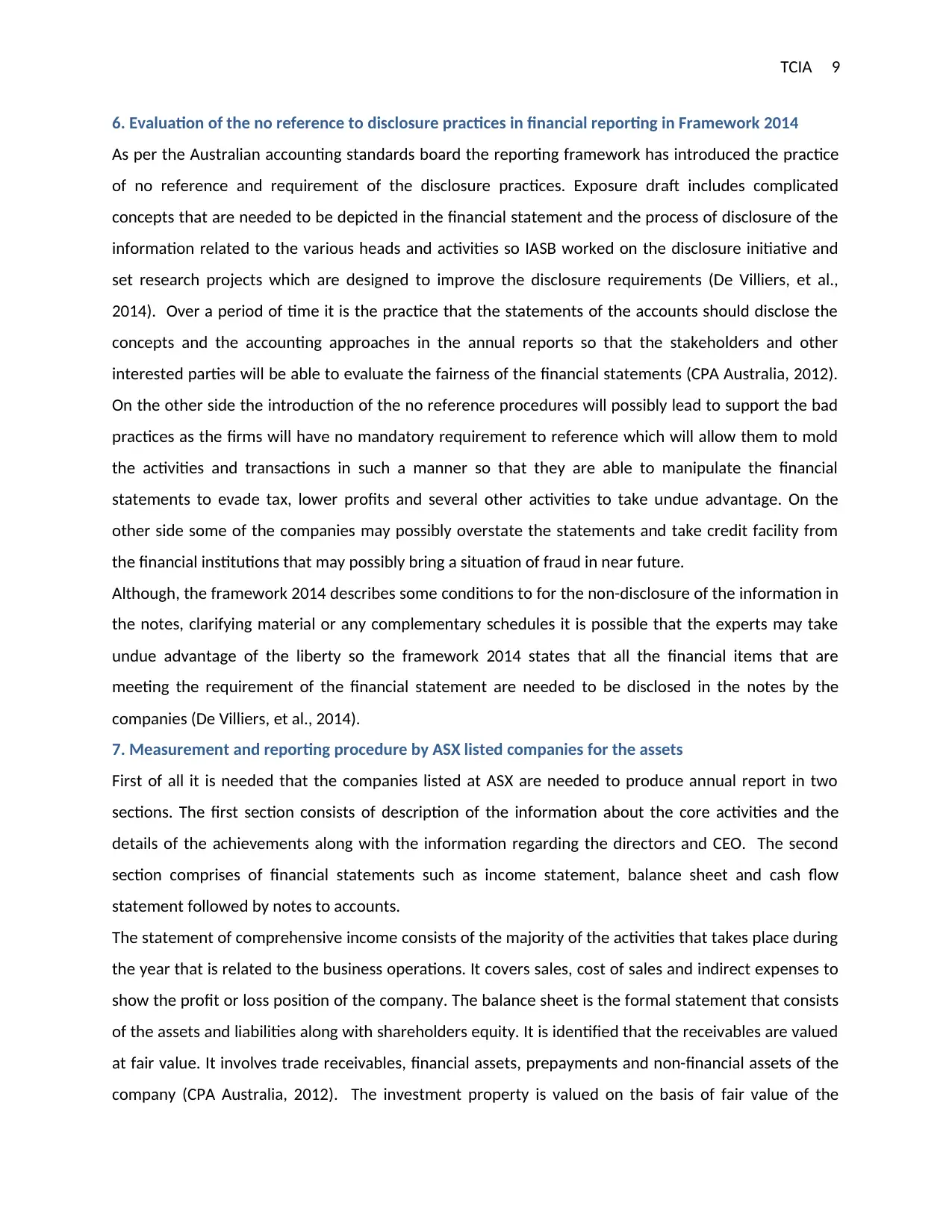
TCIA 9
6. Evaluation of the no reference to disclosure practices in financial reporting in Framework 2014
As per the Australian accounting standards board the reporting framework has introduced the practice
of no reference and requirement of the disclosure practices. Exposure draft includes complicated
concepts that are needed to be depicted in the financial statement and the process of disclosure of the
information related to the various heads and activities so IASB worked on the disclosure initiative and
set research projects which are designed to improve the disclosure requirements (De Villiers, et al.,
2014). Over a period of time it is the practice that the statements of the accounts should disclose the
concepts and the accounting approaches in the annual reports so that the stakeholders and other
interested parties will be able to evaluate the fairness of the financial statements (CPA Australia, 2012).
On the other side the introduction of the no reference procedures will possibly lead to support the bad
practices as the firms will have no mandatory requirement to reference which will allow them to mold
the activities and transactions in such a manner so that they are able to manipulate the financial
statements to evade tax, lower profits and several other activities to take undue advantage. On the
other side some of the companies may possibly overstate the statements and take credit facility from
the financial institutions that may possibly bring a situation of fraud in near future.
Although, the framework 2014 describes some conditions to for the non-disclosure of the information in
the notes, clarifying material or any complementary schedules it is possible that the experts may take
undue advantage of the liberty so the framework 2014 states that all the financial items that are
meeting the requirement of the financial statement are needed to be disclosed in the notes by the
companies (De Villiers, et al., 2014).
7. Measurement and reporting procedure by ASX listed companies for the assets
First of all it is needed that the companies listed at ASX are needed to produce annual report in two
sections. The first section consists of description of the information about the core activities and the
details of the achievements along with the information regarding the directors and CEO. The second
section comprises of financial statements such as income statement, balance sheet and cash flow
statement followed by notes to accounts.
The statement of comprehensive income consists of the majority of the activities that takes place during
the year that is related to the business operations. It covers sales, cost of sales and indirect expenses to
show the profit or loss position of the company. The balance sheet is the formal statement that consists
of the assets and liabilities along with shareholders equity. It is identified that the receivables are valued
at fair value. It involves trade receivables, financial assets, prepayments and non-financial assets of the
company (CPA Australia, 2012). The investment property is valued on the basis of fair value of the
6. Evaluation of the no reference to disclosure practices in financial reporting in Framework 2014
As per the Australian accounting standards board the reporting framework has introduced the practice
of no reference and requirement of the disclosure practices. Exposure draft includes complicated
concepts that are needed to be depicted in the financial statement and the process of disclosure of the
information related to the various heads and activities so IASB worked on the disclosure initiative and
set research projects which are designed to improve the disclosure requirements (De Villiers, et al.,
2014). Over a period of time it is the practice that the statements of the accounts should disclose the
concepts and the accounting approaches in the annual reports so that the stakeholders and other
interested parties will be able to evaluate the fairness of the financial statements (CPA Australia, 2012).
On the other side the introduction of the no reference procedures will possibly lead to support the bad
practices as the firms will have no mandatory requirement to reference which will allow them to mold
the activities and transactions in such a manner so that they are able to manipulate the financial
statements to evade tax, lower profits and several other activities to take undue advantage. On the
other side some of the companies may possibly overstate the statements and take credit facility from
the financial institutions that may possibly bring a situation of fraud in near future.
Although, the framework 2014 describes some conditions to for the non-disclosure of the information in
the notes, clarifying material or any complementary schedules it is possible that the experts may take
undue advantage of the liberty so the framework 2014 states that all the financial items that are
meeting the requirement of the financial statement are needed to be disclosed in the notes by the
companies (De Villiers, et al., 2014).
7. Measurement and reporting procedure by ASX listed companies for the assets
First of all it is needed that the companies listed at ASX are needed to produce annual report in two
sections. The first section consists of description of the information about the core activities and the
details of the achievements along with the information regarding the directors and CEO. The second
section comprises of financial statements such as income statement, balance sheet and cash flow
statement followed by notes to accounts.
The statement of comprehensive income consists of the majority of the activities that takes place during
the year that is related to the business operations. It covers sales, cost of sales and indirect expenses to
show the profit or loss position of the company. The balance sheet is the formal statement that consists
of the assets and liabilities along with shareholders equity. It is identified that the receivables are valued
at fair value. It involves trade receivables, financial assets, prepayments and non-financial assets of the
company (CPA Australia, 2012). The investment property is valued on the basis of fair value of the
⊘ This is a preview!⊘
Do you want full access?
Subscribe today to unlock all pages.

Trusted by 1+ million students worldwide
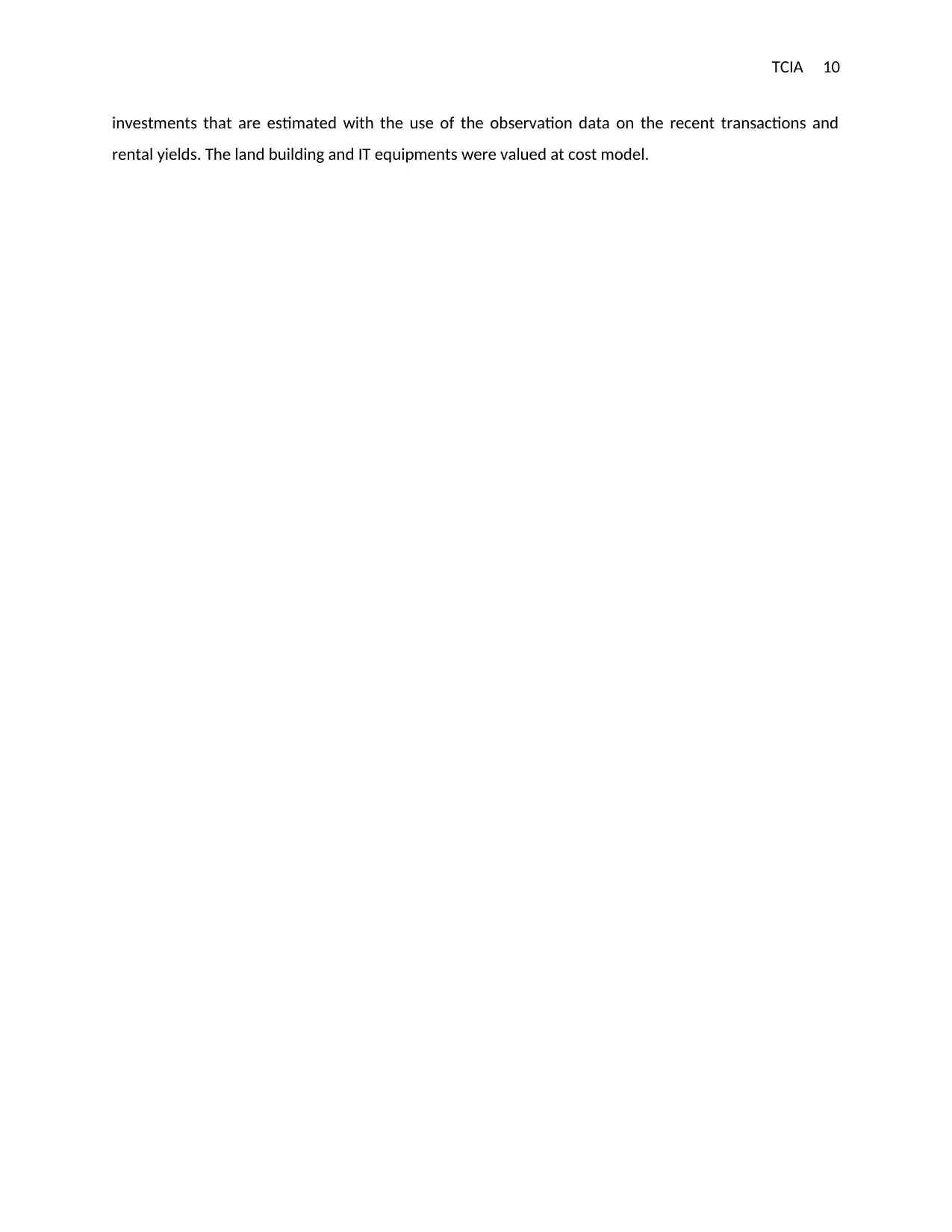
TCIA 10
investments that are estimated with the use of the observation data on the recent transactions and
rental yields. The land building and IT equipments were valued at cost model.
investments that are estimated with the use of the observation data on the recent transactions and
rental yields. The land building and IT equipments were valued at cost model.
Paraphrase This Document
Need a fresh take? Get an instant paraphrase of this document with our AI Paraphraser
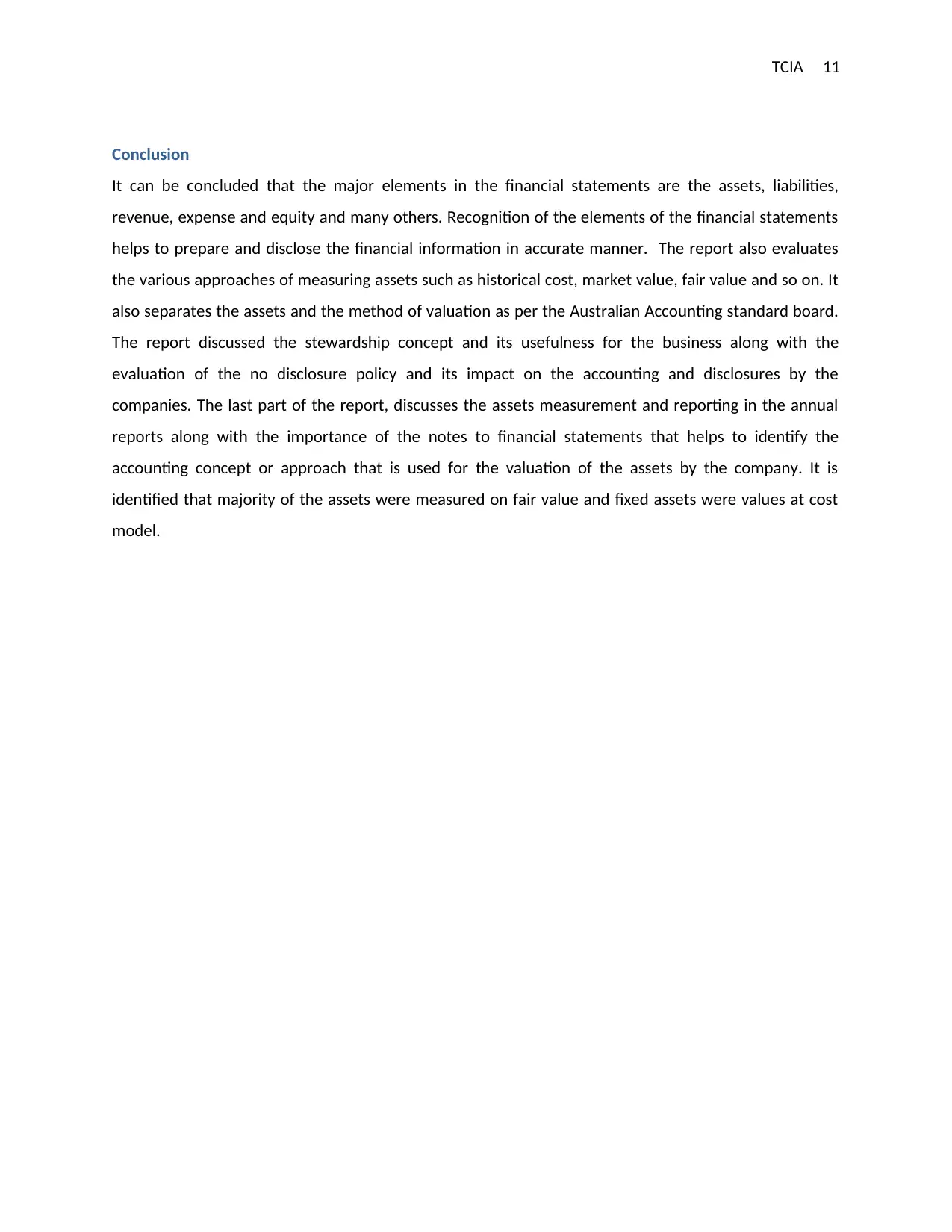
TCIA 11
Conclusion
It can be concluded that the major elements in the financial statements are the assets, liabilities,
revenue, expense and equity and many others. Recognition of the elements of the financial statements
helps to prepare and disclose the financial information in accurate manner. The report also evaluates
the various approaches of measuring assets such as historical cost, market value, fair value and so on. It
also separates the assets and the method of valuation as per the Australian Accounting standard board.
The report discussed the stewardship concept and its usefulness for the business along with the
evaluation of the no disclosure policy and its impact on the accounting and disclosures by the
companies. The last part of the report, discusses the assets measurement and reporting in the annual
reports along with the importance of the notes to financial statements that helps to identify the
accounting concept or approach that is used for the valuation of the assets by the company. It is
identified that majority of the assets were measured on fair value and fixed assets were values at cost
model.
Conclusion
It can be concluded that the major elements in the financial statements are the assets, liabilities,
revenue, expense and equity and many others. Recognition of the elements of the financial statements
helps to prepare and disclose the financial information in accurate manner. The report also evaluates
the various approaches of measuring assets such as historical cost, market value, fair value and so on. It
also separates the assets and the method of valuation as per the Australian Accounting standard board.
The report discussed the stewardship concept and its usefulness for the business along with the
evaluation of the no disclosure policy and its impact on the accounting and disclosures by the
companies. The last part of the report, discusses the assets measurement and reporting in the annual
reports along with the importance of the notes to financial statements that helps to identify the
accounting concept or approach that is used for the valuation of the assets by the company. It is
identified that majority of the assets were measured on fair value and fixed assets were values at cost
model.
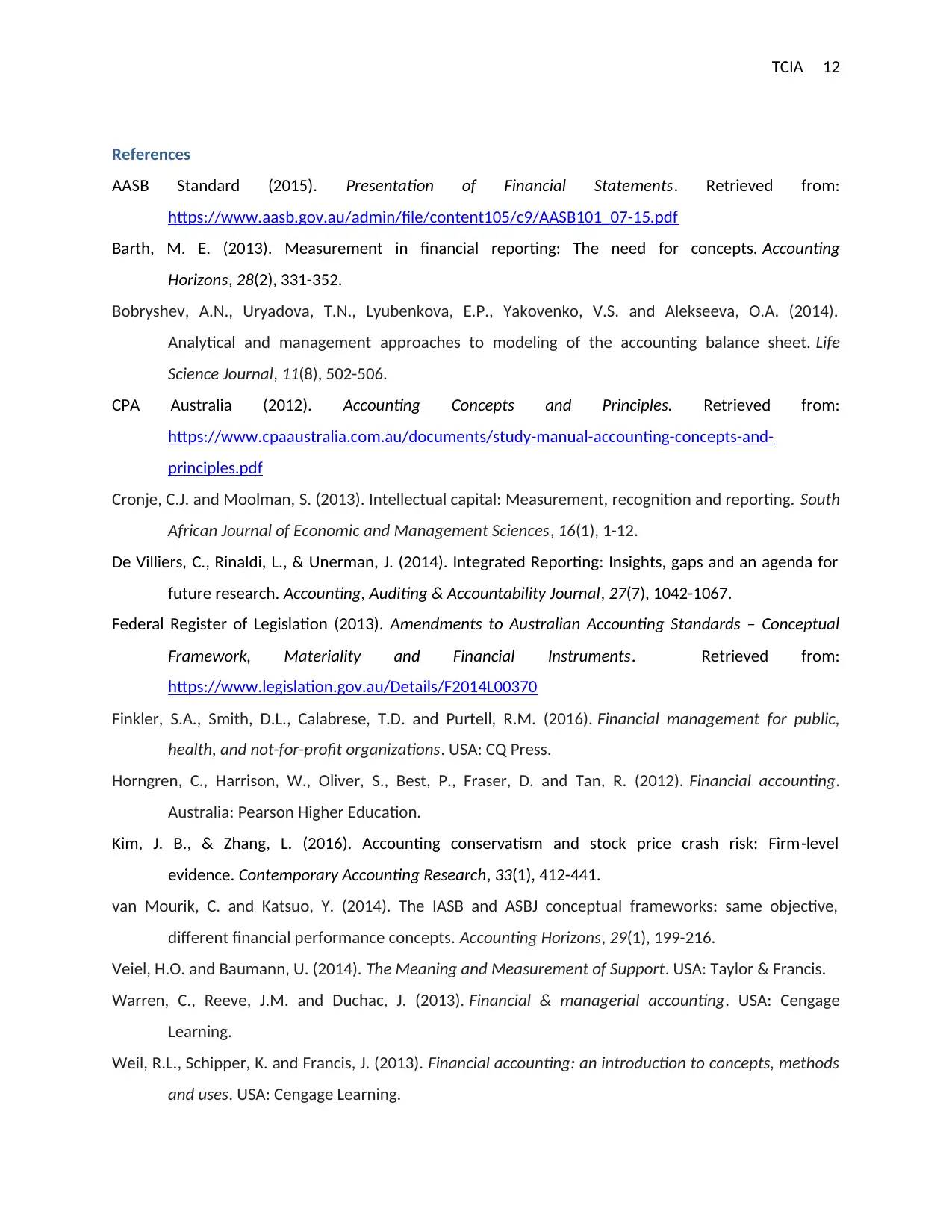
TCIA 12
References
AASB Standard (2015). Presentation of Financial Statements. Retrieved from:
https://www.aasb.gov.au/admin/file/content105/c9/AASB101_07-15.pdf
Barth, M. E. (2013). Measurement in financial reporting: The need for concepts. Accounting
Horizons, 28(2), 331-352.
Bobryshev, A.N., Uryadova, T.N., Lyubenkova, E.P., Yakovenko, V.S. and Alekseeva, O.A. (2014).
Analytical and management approaches to modeling of the accounting balance sheet. Life
Science Journal, 11(8), 502-506.
CPA Australia (2012). Accounting Concepts and Principles. Retrieved from:
https://www.cpaaustralia.com.au/documents/study-manual-accounting-concepts-and-
principles.pdf
Cronje, C.J. and Moolman, S. (2013). Intellectual capital: Measurement, recognition and reporting. South
African Journal of Economic and Management Sciences, 16(1), 1-12.
De Villiers, C., Rinaldi, L., & Unerman, J. (2014). Integrated Reporting: Insights, gaps and an agenda for
future research. Accounting, Auditing & Accountability Journal, 27(7), 1042-1067.
Federal Register of Legislation (2013). Amendments to Australian Accounting Standards – Conceptual
Framework, Materiality and Financial Instruments. Retrieved from:
https://www.legislation.gov.au/Details/F2014L00370
Finkler, S.A., Smith, D.L., Calabrese, T.D. and Purtell, R.M. (2016). Financial management for public,
health, and not-for-profit organizations. USA: CQ Press.
Horngren, C., Harrison, W., Oliver, S., Best, P., Fraser, D. and Tan, R. (2012). Financial accounting.
Australia: Pearson Higher Education.
Kim, J. B., & Zhang, L. (2016). Accounting conservatism and stock price crash risk: Firm level‐
evidence. Contemporary Accounting Research, 33(1), 412-441.
van Mourik, C. and Katsuo, Y. (2014). The IASB and ASBJ conceptual frameworks: same objective,
different financial performance concepts. Accounting Horizons, 29(1), 199-216.
Veiel, H.O. and Baumann, U. (2014). The Meaning and Measurement of Support. USA: Taylor & Francis.
Warren, C., Reeve, J.M. and Duchac, J. (2013). Financial & managerial accounting. USA: Cengage
Learning.
Weil, R.L., Schipper, K. and Francis, J. (2013). Financial accounting: an introduction to concepts, methods
and uses. USA: Cengage Learning.
References
AASB Standard (2015). Presentation of Financial Statements. Retrieved from:
https://www.aasb.gov.au/admin/file/content105/c9/AASB101_07-15.pdf
Barth, M. E. (2013). Measurement in financial reporting: The need for concepts. Accounting
Horizons, 28(2), 331-352.
Bobryshev, A.N., Uryadova, T.N., Lyubenkova, E.P., Yakovenko, V.S. and Alekseeva, O.A. (2014).
Analytical and management approaches to modeling of the accounting balance sheet. Life
Science Journal, 11(8), 502-506.
CPA Australia (2012). Accounting Concepts and Principles. Retrieved from:
https://www.cpaaustralia.com.au/documents/study-manual-accounting-concepts-and-
principles.pdf
Cronje, C.J. and Moolman, S. (2013). Intellectual capital: Measurement, recognition and reporting. South
African Journal of Economic and Management Sciences, 16(1), 1-12.
De Villiers, C., Rinaldi, L., & Unerman, J. (2014). Integrated Reporting: Insights, gaps and an agenda for
future research. Accounting, Auditing & Accountability Journal, 27(7), 1042-1067.
Federal Register of Legislation (2013). Amendments to Australian Accounting Standards – Conceptual
Framework, Materiality and Financial Instruments. Retrieved from:
https://www.legislation.gov.au/Details/F2014L00370
Finkler, S.A., Smith, D.L., Calabrese, T.D. and Purtell, R.M. (2016). Financial management for public,
health, and not-for-profit organizations. USA: CQ Press.
Horngren, C., Harrison, W., Oliver, S., Best, P., Fraser, D. and Tan, R. (2012). Financial accounting.
Australia: Pearson Higher Education.
Kim, J. B., & Zhang, L. (2016). Accounting conservatism and stock price crash risk: Firm level‐
evidence. Contemporary Accounting Research, 33(1), 412-441.
van Mourik, C. and Katsuo, Y. (2014). The IASB and ASBJ conceptual frameworks: same objective,
different financial performance concepts. Accounting Horizons, 29(1), 199-216.
Veiel, H.O. and Baumann, U. (2014). The Meaning and Measurement of Support. USA: Taylor & Francis.
Warren, C., Reeve, J.M. and Duchac, J. (2013). Financial & managerial accounting. USA: Cengage
Learning.
Weil, R.L., Schipper, K. and Francis, J. (2013). Financial accounting: an introduction to concepts, methods
and uses. USA: Cengage Learning.
⊘ This is a preview!⊘
Do you want full access?
Subscribe today to unlock all pages.

Trusted by 1+ million students worldwide
1 out of 13
Related Documents
Your All-in-One AI-Powered Toolkit for Academic Success.
+13062052269
info@desklib.com
Available 24*7 on WhatsApp / Email
![[object Object]](/_next/static/media/star-bottom.7253800d.svg)
Unlock your academic potential
Copyright © 2020–2025 A2Z Services. All Rights Reserved. Developed and managed by ZUCOL.





